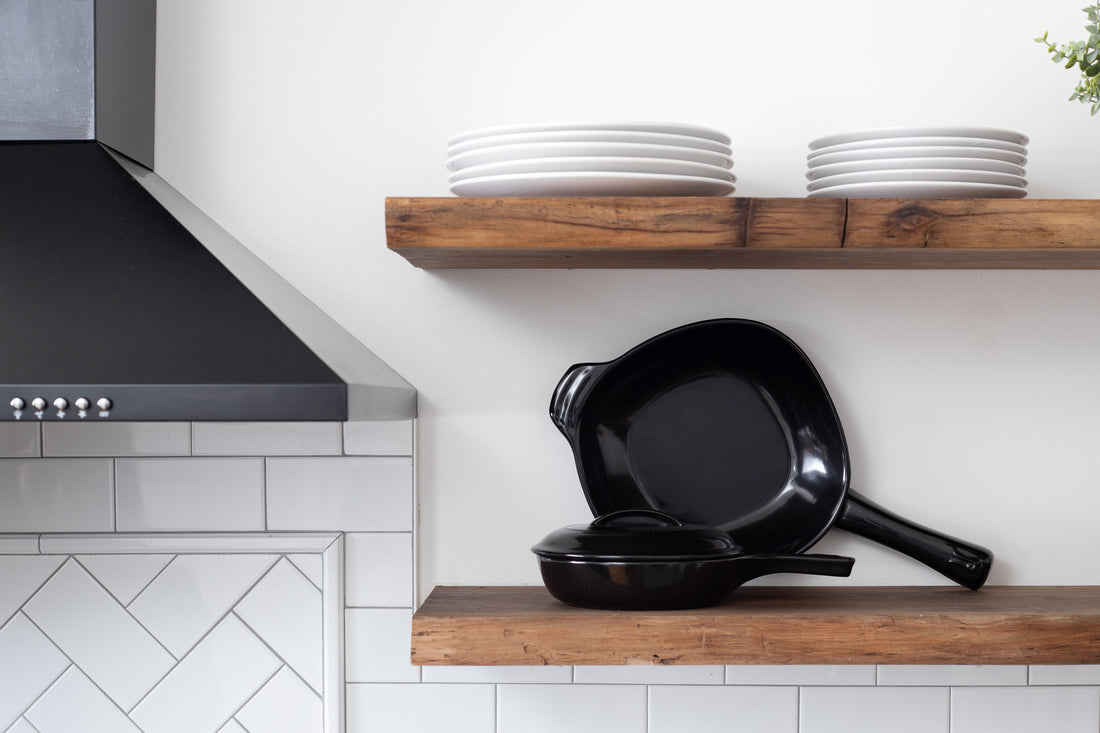Contrary to popular belief, sauté pans and skillets aren’t actually the same thing. These are two of the best types of pans home cooks and chefs can have and they can often be used interchangeably, but they are different enough to justify having both.
Understanding how a sauté pan is different from a skillet can help you feel more confident in the kitchen and save you time deliberating over which pan is best.
Sauté Pan vs. Skillet
A sauté pan is a large pan with straight sides, a long handle, and a lid. A skillet, often called a frying pan or fry pan, is a shallow pan with sloped sides and long handle, and it may or may not come with a lid as well.
Sides
The biggest difference between these pans is the angle and height of the sides. It is common to see the sides of saute pans measuring between two and up to about four inches, but the height and angle of skillet sides varies. Some skillets have very short sides while others are more substantial and these sides could be flared out at dramatic angles or angled only slightly.
Differences in the angle of the sides affect the actual cooking surface area of both pans. For instance, a sauté pan measuring 12 inches across will actually have more space for food to directly contact than a skillet measuring 12 inches across because the skillet loses some of its cooking area to its flared sides but a sauté pan with its right angles does not.
Surface Area
Sauté pans are usually larger in size as they are designed for sautéing, which requires a lot of space for food to spread out. If their bottoms were small, they would not be much different than a sauce pan.
You are unlikely to see a sauté pan that measures less than 12 inches in diameter, but skillets range anywhere from eight to 12 inches across.
Size (Volume vs. Diameter)
Another main difference between these pans is the way that they are measured.
Because of the way saute pans are shaped, they are usually measured by volume. Two- or three-quart sauté pans are common, but these pans can hold anywhere from two to seven quarts. But measuring skillets like this wouldn’t make sense as these pans are shallow and have flared edges, so these are measured by calculating the distance from one side to another.
The average sauté pan tends to be larger than the average skillet, but it’s hard to tell when a skillet can hold the same volume as a sauté pan because this information is not usually provided.
How to Know Which Pan to Use
Many people decide to keep both a sauté pan and a skillet (or two) handy rather than choosing between them. But if you do have both, how do you when it’s time for the sauté pan and when it’s time for a skillet?
Using a skillet when you should have used a sauté pan is unlikely to ruin any meals for you, but knowing how and when to use each of these types of cookware is a good way to make the most of your pans and potentially save yourself time.
In general, saute pans are more useful than skillets for longer cook times and sauces, while skillets are slightly more useful for short, high heat cooking. Here’s a breakdown of each pan’s strengths and weaknesses.
Sauté Pan Strengths and Weaknesses
Sauté pans can be used for sautéing, searing, and other forms of high heating cooking thanks to their large surface areas. But because sauté pans have lids and high, straight sides, these pans are also great for prolonged, low-heat cooking. If you have something that you want to reduce, simmer, or even boil, a sauté pan is the clear winner.
Sometimes, trapping liquids and juices isn’t favorable. If, for example, you’re trying to sear seafood such as scallops, the liquids may get trapped in along the edges of your pan and take a while to evaporate.
Skillet Strengths and Weaknesses
Skillets come out slightly on top when it comes to searing because they can do this a little more quickly than sauté pans. For example, if you’re trying to sear seafood such as scallops over high heat, you may find that you can do this more quickly with a skillet because the scallops’ natural juices will evaporate at a faster rate than they would in a straight-sided sauté pan.
But because skillets can’t hold much liquid, they are worse than sauté pans for reductions and stews. And if your skillets don’t have lids, you will need to use a sauté pan when you’re doing stovetop cooking and want to trap the heat in.
All this said, ultimately the best choice in any given scenario depends on what size pans you’re working with. An 8-inch frying pan, for example, is going to be a poor choice for reducing sauces or cooking for more than one person. But larger skillets won’t be a lot different than saué pans in most applications.
What Kind of Sauté Pan Is Best?
As always, stay away from nonstick pans. Though it may be tempting to reach for the cheap sauté pan that will offer clean up easily, pans with nonstick coatings are flimsy and have short life spans. And on top of this, they are not safe to use because of the chemicals they contain.
You want a sauté pan that is as sturdy and durable, made from earth-friendly materials that won’t leach chemicals and metals into your food. While stainless steel and carbon steel pans are generally high-quality and long-lasting, these metals are reactive to certain acidic foods and may leach metals such as iron and nickel into whatever you’re cooking.
To be safe, choose a quality cookware brand and consider investing in pure ceramic as opposed to clad stainless steel or a stainless pan.
